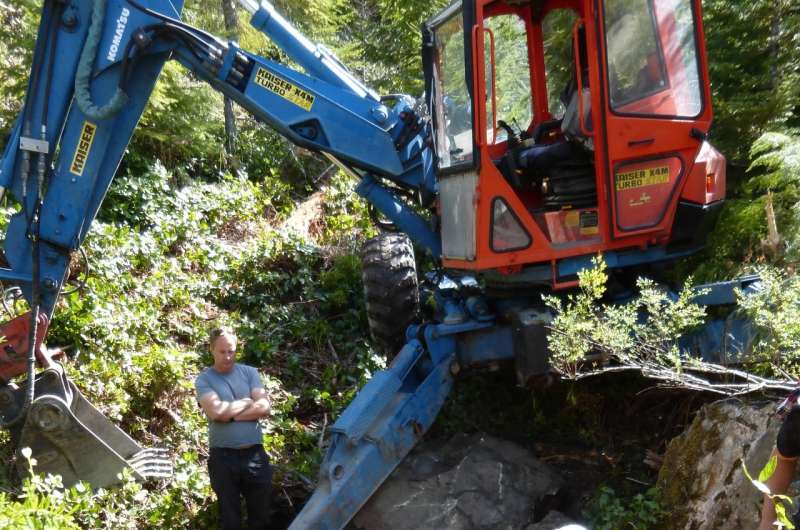Quiescent British Columbia fault capable of producing large earthquakes

A Canadian fault scientists thought was inactive may actually be capable of producing large-magnitude earthquakes, a new study finds. The results suggest residents of British Columbia on Canada's west coast have a higher risk of experiencing a damaging earthquake than previously thought, according to the study's authors.
The Leech River fault, which extends across the southern tip of Vancouver Island, is part of the Cascadia Subduction Zone, where scientists think there is about a 40 percent chance a megathrust earthquake of 9.0 or more magnitude could occur in the next 50 years, according to the Oregon Office of Emergency Management. Scientists thought the Leech River fault itself was inactive, but the new study shows it produced three surface-rupturing earthquakes in the last 10,000 years with a magnitude greater than 6.5 and is still capable of producing large earthquakes.
The results suggest the part of the Cascadia Subduction Zone running through Canada could contain additional potentially dangerous active faults scientists aren't even aware of yet, according to Kristin Morell, an assistant professor of Earth science at the University of California Santa Barbara and previously at the University of Victoria. Morell is lead author of the new study in Geophysical Research Letters, a journal of the American Geophysical Union.
Morell herself lived on the Leech River fault, which runs from Sombrio Beach through Royal Roads University and offshore of downtown Victoria. She published initial evidence for earthquake surface ruptures along the fault in 2017.
"Even though the fault had not shown any detectable seismic activity for thousands of years and was believed to be inactive, I had a strong suspicion that it could produce damaging surface rupturing earthquakes because it appears to connect with the Devil's Mountain fault," Morell said. The Devils Mountain fault has been found to be capable of causing a magnitude-7.5 earthquake off Victoria in United States Geological Survey scenarios.
In the new study, Morell and her team constructed a surface rupture history of the Leech River fault using data collected with a LiDAR (Light Detection and Ranging) system, which maps the Earth's terrestrial surface by sending laser pulses from an aircraft, and paleoseismic trenching, which involves digging across the face of a fault to look for evidence of past surface rupture.
In addition to revealing a history of surface-rupturing earthquakes produced by the Leech River fault, the study also showed that in the past, rocks on either side of the fault moved vertically with respect to each other, even though other evidence says the fault should behave more like the San Andreas strike slip fault, where two blocks of rock slide past one another laterally.
Morell and her team said they don't yet know why the Leech River fault moves differently from what they would have anticipated, but the new finding helps scientists understand how all the faults in the region fit together to accommodate the build-up of stresses within the earth, and how the fault will behave in the long term.
The new study also provides direct dating of earthquakes on this kind of fault, making it possible for scientists to calculate the slip rate per year, which is used in seismic hazard models for building and safety codes. These codes need to be updated to reflect how the Earth is moving near densely populated areas and how movement will affect the infrastructure and people living there, according to Morell.
Neither the rate nor the direction of movement of the fault could have been known without paleoseismic trenching and LiDAR technology. The technology is expensive, but without it it's impossible to know what's underneath 60 million hectares of trees, which cover close to two-thirds of the province of British Columbia, Morell said.
As a field geologist, Morell has a unique perspective on what it means to be aware of the environment, and our place in it as humans.
"I think it's important for all of us to understand our surroundings and the landscape that we are a part of," said Morell. "All of us as a society should have a grasp on the larger time scale of the Earth, where events leading up to the catastrophes we see in our lifetimes occur over millions of years."
More information: K. D. Morell et al. Holocene surface rupture history of an active forearc fault redefines seismic hazard in southwestern British Columbia, Canada, Geophysical Research Letters (2018). DOI: 10.1029/2018GL078711
Journal information: Geophysical Research Letters
Provided by GeoSpace
This story is republished courtesy of AGU Blogs (http://blogs.agu.org), a community of Earth and space science blogs, hosted by the American Geophysical Union. Read the original story here.


















